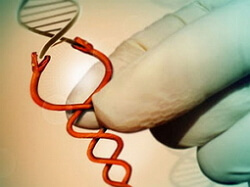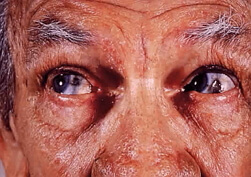Hemophilia
 Hemophilia is a pathology that is inherited from generation to generation and is characterized by reduced blood coagulability. Exclusively, women are the conductors of hemophilia, and they are sick, mostly men.
Hemophilia is a pathology that is inherited from generation to generation and is characterized by reduced blood coagulability. Exclusively, women are the conductors of hemophilia, and they are sick, mostly men.
There are two main types of hemophilia. This pathology is based on the defeat of the female sex chromosome gene, which is responsible for the formation of antihemophilic globulin( factor VIII) and Christmass disease( factor IX).There is still hemophilia C, which is characterized by a deficiency of factor XI.This type of hemophilia is very rare and occurs in 5% of cases in women. Since the basis of hemophilia is bleeding, as a result of congenital pathology, it lasts much longer than in healthy people.
Hemophilia causes
An hereditary factor is the main cause that provokes the development of hemophilia. In the formulation of the diagnosis, special attention is paid to the history, hematoma type of bleeding and laboratory studies.
Hemophilia is transmitted at the genetic level and is characterized by inferior clotting of blood. When diagnosing, special attention is paid to the clotting time of platelets. Heavy forms of hemophilia are characterized by a longer duration of this time and reduced consumption of prothrombin. If a patient's blood defect can be eliminated with a plasma that has been previously adsorbed with barium sulfate, and then the antihemophilic factor present in it is found and factor IX is absent, then a diagnosis of hemophilia A is made. When a pathological abnormality in the blood can be eliminated with normal serum, The second type of hemophilia( B).
Two types of hemophilia, A and B, are inherited by the X-linked recessive type. In women, as a rule, there are two X-chromosomes, and in men - only one. Therefore, when the boys receive the X-linked damaged gene from the mother, they can not replace it with any other chromosome, since they only have one Y chromosome. Therefore, hemophilia mostly affects the boys, then passed from them to their future daughters, who become bearers of the affected gene. Studies show that almost 80% of mothers whose sons have hemophilia are the conductors of this disease. And only in very extreme cases, hemophilia affects women.
In addition, when examining a certain percentage of the mothers of those boys who suffer from hemophilia, they did not find a mutation of the genes, which meant their defeat already in the process of formation of parental germ cells. Thus, hereditary pathology can appear in the absence of parents carrying genes that carry hemophilia.
Therefore, in order to completely interrupt this pathological chain, it is necessary to apply a fairly strict advice of geneticists and with special care to plan future offspring. Using the recommendations of modern geneticists, female carriers of the affected gene, you can not give birth to children at all. Those families in which men are sick with hemophilia, and women are healthy, it is desirable to give birth only to boys. And for pregnant women, women are offered to conduct an artificial abortion procedure.
At the moment, scientists are developing methods to address issues that could in the future eliminate the cause of hemophilia. But while it is very difficult to do this, because everything is at the genetic level, that is, in the human gene. Therefore, patients need to learn to live in a society with such a disease and always be very cautious, careful about themselves. Because, suffering from hemophilia, the danger for the death of a patient as a result of hemorrhages in the meninges or other organs, no less important, even at the slightest trauma, can sharply increase.
Hemophilia gene
Recently, significant discoveries have been made in the biochemical field of hemophilia, which help to observe, diagnose and treat hemophilia.
Today, it is already proved that the deficit factor VIII present in hemophilia A and the von Willebrand factor( B), which is located at the high molecular point, differ among themselves by enzymes and are in the blood in the form of unbound complexes. The content of the amount of factor VIII in plasma is much less than that of factor B, therefore it is the carrier of a protein very necessary for the secretion of antihemophilic globulin and its protection against destruction.
Back in 1984, genetic scientists identified a gene that is responsible for the formation of factor VIII and clarified its structure. It is located on the shoulder of the X chromosome, which includes twenty-six exons and twenty-five introns. This gene is known as one of the largest human genes. In its structure there are three domains of type A, two domains C and one domain B, which is rich in carbohydrates. It antihemophilic globulin( cp VIII) fulfills a major role in clotting as nonprotein substances and thus accelerates the action of factor X.
gene which is located on the long arm of the X chromosome at the site IX, it is a consequence of hemophilia B, andIs formed in the liver with the participation of vitamin C. And as a result of a deficiency in the activity of both factors, a clotting disorder occurs that results from prolonged bleeding.
Thus, it can be concluded that the gene encodes HEMA antihemophilic factor A, which is fixed on platelets and is synthesized in the liver with vitamin K and participates in the formation of thromboplastin. With Christmass disease( hemophilia B), the deficiency of the plasma thromboplasty component also leads to poor blood coagulation. Symptoms of hemophilia
Clinical manifestation of hemophilia A is not different from the second type of hemophilia B. This disease is characterized by bleeding manifestations of hemorrhages into the joints of limbs, subcutaneous, intramuscular and intermuscular hematomas, profuse bleeding prolonged nature trauma, after manipulation. Less frequently observed bleeding from the gastrointestinal tract, intracranial hemorrhage, retroperitoneal hematoma, hematuria, and hemorrhage into the abdominal cavity.
Haemophilia is characterized by age-related symptoms of the disease. In very difficult moments when the child appears, even in the maternity hospital, there are traces of cephalohematemata and bleeding of the umbilical wound.
Very often, the first symptoms of hemophilia are detected in connection with bleeding, which appear after manipulation in the form of injections, punctures, and surgical operations.
The first manifestations of hemorrhage in the joints are traced when the child begins to crawl, and then walk. First of all, the knees, elbows, shins and feet suffer, hip and shoulder joints are more rarely affected. But hemarthroses arise, as a rule, without visible trauma, but the joints become painful, hot, rigid and bent. Pain prevents movement.
Hemorrhages in the joints, at first glance, are harmless. The blood is gradually reabsorbed, the edema disappears, and the articular function is restored. At X-ray examination, changes are not observed. But after frequent such hemorrhages the capsule of the joint thickens and changes its color. In the future, the inflammatory process increases. In later terms, arthropathy is expressed by the characteristic fibrosis of the capsule and soft tissues that surround the joint, which leads to limitations in its mobility. The articular cartilage changes, and after repeated hemorrhages is destroyed by the action of active enzymes and collagenases on it. In very severe forms of arthropathy, mobility, ankylosis, is completely lost. And if substitution therapy is not used, the patient faces a wheelchair or crutches.
Various types of diseases quite often become the causes of bleeding from the gastrointestinal tract. The most common among them are the different types of erosion in the stomach and duodenum, as well as expansion of varicose veins in the esophagus and hemorrhagic components, which can be provoked by intake of non-steroidal drugs. Sometimes such bleeding can occur spontaneously.
But the abundant renal bleeding creates serious therapeutic problems, which are diagnosed in patients with hemophilia. They occur in almost 20% of patients. Such types of bleeding occur both unexpectedly and as a result of injuries in the lumbar region, with the available pyelonephritis, as well as after taking aspirin or non-steroid preparations.
During hematuria patient manifested seizures associated with urination disorders and severe pain in the lumbar region, which resulted in the urinary tract form clots that may cause hydronephrosis. Everyone knows that such kidney hemophilic hemorrhages are much more difficult to treat than hemorrhages in other locations.
Hemophilia in children
In patients with hemophilia of children, violations associated with the functions of platelets are not fully understood. A clinical picture of hemophilia is characterized by typical flow and repeated haemorrhages in the form of hematomas and hemarthrosis. In general, the first symptoms of hemophilia in severe form manifest in most children until the end of the first year of life. But recently, thanks to the use of prenatal diagnostics with the use of equipment at the modern level, it has become much more common to diagnose the pathology of the fetus even before birth.
In the first place in the clinical picture of newborns there are bleedings that appear from the umbilical wound, places after injections, and small hematomas, which then appear under the skin and in different areas of the mucous membranes.
For joint hemorrhages, the age of the children is two or three years. In some small patients, petechiae or ecchymoses occur simultaneously with hemarthroses and hematomas, which appear unexpectedly or during minor physical exertion, which is not characteristic of hemophilia.
Children of preschool age and school often complain of bleeding from the gums and nose that are recurrent. And also there are episodic hematuria.
Gemarthroses( extensive bruises) are a common problem of sick children, which develops chronic forms of synovitis, arthropathies and contractures. Therefore, such children are prohibited from any setting of intramuscular injections, since this manipulation can lead to a not very intense, but at the same time, long-terminating bleeding. To vaccinate and administer drugs preferably only subcutaneously, using a thin needle.
During internal bleeding in the feces of a child, during research, the blood is found. And this already speaks about the beginning anemia of the patient. In young children, bleeding associated with the urinary tract is rare, but the frequency of hematuria sometimes increases with age. In addition, bleeding occurs in the internal organs.
Rare, but deadly, hemorrhages in the brain envelopes, which can cause the child to develop severe organic lesions of the central nervous system. This is characterized by the predominance of excitation processes over inhibitions. Such children behave in an undisciplined manner and can be naughty. According to external data, they have a fragile physique and they have reduced appetite. Internal organs do not change at the time beyond bleeding.
With age, children develop complications more often. And all this is due to reduced immunity, as a consequence of the underlying disease. Hemophilia can lead to hemolytic anemia, leukopenia, thrombocytopenia and inflammation of the kidneys, turning into kidney failure, and this is already a disability.
Hemophilia in women
This kind of disease is extremely rare among girls and women, therefore, there are very few clinical descriptions of hemophilia in women.
Hemophilia in the weaker sex occurs only when the sick, father and mother, handed the girl the affected gene. Theoretically, such parents can give birth in the same proportion as a girl-conductor of the disease, as well as a girl with obvious clinical symptoms, or a sick boy with hemophilia, and vice versa, absolutely healthy.
One of the most common abnormalities of blood clotting in girls and women is Willebrand disease, which is about one percent of patients. They are mostly women of the USA.
Hemophilia in women indicates a deficiency of von Willebrand factor, which should produce a special protein necessary for blood clotting. There are other types of disorders that lead to bleeding. The Shereshevsky-Turner syndrome is diagnosed when it is possible to determine monosomy on the X chromosome of the full or partial shape. But Klinefelter's syndrome is put in the determination of rice.
Since hemophilia mainly occurs in four clinical forms, such as mild, stunted, moderate and severe, girls and women are only diagnosed with mild illness. Such women are prone to nosebleeds, they have profuse menstruation. And also minor operations, such as tooth extraction or tonsillectomy, can lead to difficult bleeding stops.
Hemophilia in men
Poor clotting of blood to boys is transmitted through practically healthy mothers, who are conductors of a pathologically altered gene.
The first manifestations of hemophilia, parents notice as a child and they are characterized by small bleeding, which can occur after different types of injuries. This may be bruises, tooth extraction, etc. But bruising already indicates more serious hemorrhages under the skin and in the muscles. Such hematomas cause necrosis of the tissues due to the constriction of the vessels that supply them with food. The infection that occurs in them can cause such a serious disease as sepsis. Hemorrhages that lead to the necrosis of the bones occur in the bone tissue. Sometimes hematomas can be very large and cause even gangrene or paralysis.
In carrying out any surgical intervention, a hemophilia patient must be injected with antihemophilic drugs to avoid severe blood loss.
Hemorrhages in the meninges are considered dangerous, which, as a rule, cause death of the patient or severe form of CNS damage.
The most complex bleeding in men is considered retroperitoneal, which stimulates the emergence of acute surgical diseases in the peritoneum. Often developing posthemorrhagic anemia is observed after gastrointestinal, nasal bleeding, as well as from the urinary tract and gum.
Hemarthroses, that is, joint hemorrhages, are usually accompanied by fever above 38˚ and their soreness. Often relapsing hemorrhages into the joints cause the development of osteoarthritis, and it leads to the restriction of movements in all joints and atrophies of the muscles of the extremities, which in the future can lead to a wheelchair. In the beginning, the joints of the knees and elbows are affected, and then the smaller ones.
Bleeding from the mucous membranes in the throat or larynx is also considered dangerous. This often occurs during an attack of coughing, screaming and even tense vocal cords, which results in an obstruction of the airways.
Hemophilia treatment of
The main point in the treatment of patients with hemophilia is the ability to compensate for the deficiency in the factor of blood clotting. Sometimes performing surgical interventions is simply necessary to treat complications that can be caused by hematomas, hemarthroses and contractures. All these surgical interventions require a special approach.
Treatment of hemophilia is important to begin already with the first manifestations of bleeding. If it is started later, then we will have to use a certain specialized course of treatment.
Immediately with hemophilia, native plasma or lyophilized, whole blood or preparations containing factor concentrates VIII and IX are administered. To achieve the necessary level of antihemophilic factor in the blood, it is necessary to inject plasma and blood in sufficient amounts. But it is important to consider that they should not exceed 25 ml / kg of body weight of a person in 24 hours. Since repeated infusions in large volumes can lead to anaphylactic shock, the formation of antibodies to factors VIII and IX, and disrupt the work of the kidneys.
Cryoprecipitate is much more effective in the treatment of hemophilia. It is in the state of a standard dry concentrate and is well preserved at room temperature, and is also convenient in transportation. All preparations with gematransfusion are administered intravenously and the administration is repeated every 8-12 hours, considering that it is not kept in diluted form for long.
Controlling transfusion therapy, monitor the quality of factor VIII in the blood. To moderate moderate hemorrhages, you should increase the level of VIII to 20%, and to do this, an antihemophilic plasma is administered at a dosage of 10-15 ml / kg of the body weight of the patient. During heavy bleeding calculations are doubled and cryoprecipitate, as well as other concentrates are administered at 20-30 ml / kg and more.
For external bleeding, local anesthesia and treatment are used. To do this, clean the wounds from clots and wash with penicillin, diluted with saline NaCl. Then apply gauze bandages with haemostatic agents. It can be Adrenaline, Hydrogen peroxide, human or animal blood serum.
For patients with hemophilia A, transfusion is used directly from the donor's blood directly, because as a result of storage, the process of destruction of antihemophilic globulin occurs. But the blood of donors is absolutely suitable for hemophilia B, because it contains enough thromboplastin.
For the treatment of hemophilia of types B and C, a good effect is achieved using human serum and excilon-aminocaproic acid( older children are administered up to 100 ml of 5% solution three or four times a day).
Hematomas that are in capsules are removed surgically. And simultaneously used in the treatment of concentrates of anti-hemophilic factors. Gastrointestinal bleeding is stopped by applying in large doses of these concentrates with aminocaproic acid.
To restore the affected musculoskeletal system, it is necessary to treat hemophilia in the complex. And for this, different methods of synovectomy, achilloplasty and physiotherapy are used. With joint hemorrhages without complications, it is necessary to observe rest and apply cold compresses to the affected site. Then such a joint is fixed with a gypsum longus for up to four days, and after that procedures with UHF are prescribed.
In general, symptomatic treatment of hemophilia is applied to patients with hemarthrosis. First of all, it is important to create immobility to the affected joints, prescribe non-steroidal anti-inflammatory drugs and topically apply glucocorticoids.
To stop patients suffering bleeding with an inhibitory form of hemophilia, large doses of concentrates are administered simultaneously with plasmaphoresis. This allows for effective treatment, but there is a risk of developing thrombosis. Enhanced transfusion can cause infection of a patient with hepatitis B and lymphotropic viruses.
The prevention of bleeding remains important, and for this it is necessary to avoid injuries and cuts from childhood. And it is also desirable to do intravenous injections with concentrate VIII for 8 days, and for hemophilia B it is concentrate IX every 15 days for 15 units / kg.
Nutrition of patients with hemophilia should contain vitamins A, the whole group of vitamins B;C and D, phosphorus and Ca. In addition, doctors recommend eating peanuts. Among the prohibited preparations are: Analgin, Aspirin, Brufen, Butazolidines, Indomethacin.
It should be noted that during a period of exacerbation of symptoms of hemophilia, severe bouts of pain are noted. But the frequent use of pain medication can lead to a certain dependence. Therefore, constantly used concentrate factors from an early age, exclude dependence on analgesics.
Hemophilia is not completely cured at the moment, but it can still be controlled by injections. Patients suffering from hemophilia, when applying the right treatment, live to old age.
If the disease is incurable and the use of primary prevention is impossible, then it is necessary to prevent the occurrence of bleeding. And for this you should try not to inject drugs intramuscularly to prevent the appearance of bruising. Medications should be administered only intravenously or orally. The dentist needs to be treated for prevention, every three months to avoid tooth extraction.
Since patients with hemophilia can not engage in manual labor, it is necessary to develop intellectually.
People with a hemophilia diagnosis are recommended to have a medical examination and a check-up at a hematologist. At whom the light form of a hemophilia is revealed, are surveyed only once a year. Also, doctors are appointed to make vaccines against hepatitis A and B. Substitution therapy is carried out with the help of highly active, twice-activated virus concentrates. During acute forms of bleeding treatment is started no later than three hours after the injury. The therapy itself must contain adequate amounts to completely stop the bleeding.
Patients are absolutely forbidden to engage in sports such as boxing, football, volleyball, hockey, basketball;You can only visit the swimming pool.
Since hemophilia refers to a congenital hemorrhagic disease and it has certain problems when diagnosed, it requires expensive treatment. There are side effects during the substitution therapy, besides there are psychological and social problems, therefore, in order to provide medical assistance in this form of the disease, it is necessary to observe special measures. For this, treatment should be carried out exclusively in specialized clinics.
Each patient has a "Book of the patient with hemophilia", where the blood group, the Rh factor, the type of hemophilia, the degree of its severity must be recorded. Also in it all records of the spent medical, preventive measures and recommendations of the doctor at the time of exacerbations are kept.
Still it is necessary to remember and be sure to remember that all patients with hemophilia fall into the risk group for HIV( AIDS) and hepatitis, as in their treatment they widely use preparations that are prepared from the blood of donors.
In some countries special educational institutions have already been established that accept children of hemophiliacs. There they receive not only education, but also master the skills of feasible professions. In addition, specially designed and conducted therapeutic gymnastics helps children to strengthen muscles, joints and bones, in order to further teach them to prevent hemorrhagic relapses.
But nevertheless, among the most important preventive measures is the medical consultation of a geneticist before planning a pregnancy. If, with special methods of examination, a woman is diagnosed with a hemophilia gene, she is recommended not to have children, explaining, in advance, all the consequences of this disease.



